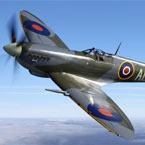CCIP-subsim
Posts: 695
Joined: 11/10/2015
Status: offline

|
That about covers the basics, well said 
Just to add to that broadly -
In terms of resolutions, yup, you should have no problem - the game scales nicely, and has several different interface size settings, meaning that if you find the icons too small (or too large) you can change the interface scale via the game start menu.
The CMANO parallel is not unfair with AB, although yeah, it's also still a game that is a bit different in scope and game flow. It's actually a bit simpler and more intuitive, especially if you're used to real-time or semi-real-time strategies - what you see is what you get, and there's much less to manage in terms of menus and doctrine settings, and more just paying attention to what's going on with the map and reacting to it.
It is definitely nothing like games such as War in the East or TOAW IV, in the sense that those are operational (and maybe even partly strategic) level games, and this one is 100% tactics (much like CMANO). You can definitely set yourself up for scenarios that are unwieldy - but that'd be purely by your own choice!
Otherwise, one thing you'll notice in terms of unit roles and performance is the sharp technological advancement in the game's 25-year timeline - again, not unlike CMANO, you'll probably see a pretty major change between the 1960s and 1980s in terms of deadliness of combat. Most of the pieces (i.e. unit types) remain the same, but their effectiveness changes pretty sharply. Early in the game timeline, tanks with their main guns are the dominant unit on the battlefield. Late in the game they're still the dominant unit, but the picture shifts somewhat, mainly thanks to the rapid advancements in guided and portable anti-tank weapons. Many light units will carry missiles by then that can kill tanks in one shot; infantry will also usually be armed with plenty of very effective man-portable weapons that will kill any tank that foolishly gets close enough. Tanks do, however, also continue to develop and become tougher, and in particular you'll see their engagement ranges and accuracy grow, with one-shot kills possible from even extreme distance. This is helped even more by the fact that many tanks will also carry guided missiles themselves.
Another thing that's useful to pay attention to is the development of mechanized infantry and their vehicles. From early in the game's timeline, you'll mostly see mechanized infantry mounted in APCs (like the US M-113 or the Soviet BTR series), which are basically just there to get your infantry to and from the battlefield - they can provide some very limited support against other infantry and might carry a heavy machinegun or something of the sort, but have no place fighting anything heavier and are best off hiding after unloading their infantry. However, very quickly along the timeline you see the development of IFVs (infantry fighting vehicles), spurred mostly by the Soviet BMP series. They are not much better protected than the typical APCs, but pack a much more substantial punch, including a cannon for 'soft' targets and even anti-tank missiles. It would be a mistake to use them like tanks (because they're still not tanks), but knowing the differences and capabilities of your mech infantry vehicles - and using them properly - is a very key skill.
The one thing that you might find to be a bit of a learning curve if you've never really dealt with it before is artillery - this game has a very good system for calling in artillery missions, but you definitely have to understand how it works and what goes into a successful artillery strike in order to use it effectively. One of the things that's crucial is having "eyes" on your targets, something that on a Cold-War-gone-hot battlefield is almost necessarily a role for infantry (because it is very unlikely that a vehicle on a battlefield full of enemy tanks will stay unseen for long). Artillery is not instant, it always comes with a delay, and it's very easy to waste it if you're not careful - but it's devastating and can make or break battles if used properly. However that also works both ways - and the AI in Armored Brigade seems to have a knack for pulverizing anything it can observe for long enough using very accurate artillery strikes. There's basically nothing you can do to stop or prevent artillery strikes - which means you have to be prepared for them. That often means keeping your units moving (or ready to move immediately), and keeping them spread out - keeping your eggs in one basket rarely works, and trying to "camp" in what seem like good positions can really cost you. The other crucial thing is having 'eyes' out front, preferably in the form of infantry, that can detect the enemy before he can detect you and hit you, whether with artillery or other units.
Otherwise, I think the roles of various units are pretty intuitive. One thing I'd encourage you not to get too hung up on is "what is good against what" - there are many ways to fight the same threats. Keep in mind that Cold War-era land combat doctrines were designed specifically to avoid setpiece head-to-head battles like those of ancient times, trench warfare of World War I, and big urban battles like some of those in World War II. Armored (or mechanized) brigades are designed to be fast and fluid, flexible enough to deal with lots of threats in lots of situations, but mainly to hit hard, engage and disengage quickly, bypass enemy units that they don't want to fight, and remain unobserved by the enemy as best as possible while they're at it. It's less a game of unit vs. counter-unit, and more a game of observation and movement. The average force in Armored Brigade has enough weapons to kill every single unit in the enemy force many times over, and a brute force approach will rarely bring anything better than a pyrrhic victory. The real trick is to put yourself in the best position to use as many of your weapons on the enemy as you can, while denying him the chance to do the same to you. It's a style of warfare that isn't as spectacular as it might seem - most actual engagements are over in seconds, or a few shots, usually with very deadly results. The fun part is when you do everything right and those few shots end up being all yours.
And yeah, there's no tutorial - but there's some good info here already, and to be honest, I find the game super intuitive in terms of actual play. Just start small and easy, and you'll be enjoying it in no time.
|
 Printable Version
Printable Version










 New Messages
New Messages No New Messages
No New Messages Hot Topic w/ New Messages
Hot Topic w/ New Messages Hot Topic w/o New Messages
Hot Topic w/o New Messages Locked w/ New Messages
Locked w/ New Messages Locked w/o New Messages
Locked w/o New Messages Post New Thread
Post New Thread